Class 7 Science Chapter 6 Question Answers - Respiration in Organisms
Q1. Insects and leaves of a plant have pores through which they exchange gases with the atmosphere. Can you write two points of differences between these pores with respect to their position, number and extension into the body?
Ans: Pores present on the sides of insects are called spiracles while pores present on the surface of leaves are called stomata. These structures are responsible for the exchange of gases with the atmosphere.
Differences between these two are as follows
- Spiracles are fewer in number as compared to stomata.
- Spiracles lead to an extensive network of tracheal system which is absent in the leaves.
Q2. Frogs are amphibians. They survive on land and water, do they have any respiratory issue? How does frog breathe when they are in water? Do they possess lungs? Explain the role of lungs in frogs.
Ans: Frog breathe by their moist skin and through lungs also. So, they do not have any, respiratory issue.
When frog enters into water, the skin of frog helps in respiration.
The oxygen rich air enters through the skin. When the frog is on land, a pair of lungs helps in respiration.
The lungs take the oxygen rich air through the nostrils from where the oxygen is absorbed by the blood and carried throughout the body. The carbon dioxide from the blood is diffused back through the skin and lungs into the atmosphere.
Q3. Name one organism who respires anaerobically. How does this organism help in beverage and baking industry?
Ans: Yeast is a single celled organism. During anaerobic respiration (also called fermentation), yeast produces ethanol or alcohol as a byproduct which is used in making wine and beer. The carbon dioxide produced by yeast is used in the bread making industry. The CO2 gas released during this process causes the bread dough to rise.
Q4. Respiration can occur in two different manners. Briefly explain the process of aerobic respiration. How does it differ from anaerobic respiration?
Ans: Types of Respiration
On the basis of the presence or absence of oxygen, respiration is classified into two types:
- Aerobic Respiration: When breakdown of glucose occurs with the use of oxygen, it is called aerobic respiration. During aerobic respiration, glucose is completely broken down into carbon dioxide and water and energy is released. Aerobic respiration takes place in mitochondria. It can be shown by the following equation:
 Aerobic respiration is seen in most of the organisms such as humans (man), dogs, cats, lions, elephants, cows, buffaloes, goats, snakes, earthworms, frogs, fishes, etc.
Aerobic respiration is seen in most of the organisms such as humans (man), dogs, cats, lions, elephants, cows, buffaloes, goats, snakes, earthworms, frogs, fishes, etc. - Anaerobic Respiration: When breakdown of glucose takes place without using oxygen, it is called anaerobic respiration. The glucose is not completely broken down into carbon dioxide and water. An intermediate compound is formed with the release of less amount of energy during this process. It can be shown as follows:
 Yeasts such as Saccharomyces cereviseae and certain bacteria carry out anaerobic respiration. These organisms that carry out respiration in the absence of oxygen are called anaerobes.
Yeasts such as Saccharomyces cereviseae and certain bacteria carry out anaerobic respiration. These organisms that carry out respiration in the absence of oxygen are called anaerobes.
Q5. After we work hard or perform physical activity, we feel hungry. Explain why.
Ans: When we work hard or perform physical activity (like running, swimming, cycling), we need mdre energy. To fulfil the energy requirement, we breathe faster. Fast breathing helps in supply of more oxygen to our cells. Due to this, rate of breakdown of food increases and more energy is released. The rapid breakdown of food makes us to feel more hungry.
Q6. Observe the given diagram of human respiratory system. List the organs from (A) to (G).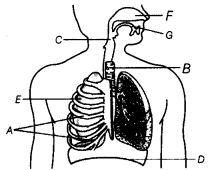 Ans:
Ans:
The human respiratory system have following organs:
A-Ribs
B-TracheaC-Pharynx
D-Diaphragm
E-Lungs
F-Nasal passage
G-Oral cavity
Q7. Breathing rate of a person is not always constant. Give the reason for your answer.
Ans: The number of times a person breathes in a minute is termed as breathing rate. An adult human being can inhale and exhale 15-18 times in a minute. It is the average breathing rate of an adult human being.
Breathing rate of a person is not always constant. It changes according to the oxygen requirement of the body. Breathing rate is somewhat faster in women than in men and in children it is higher (20-30 times/min) than adults. Breathing rate is slowest while sleeping (as less energy is required) while maximum during heavy exercise like running, weight lifting, etc. (much energy is required). Increased breathing rate provides greater amount of air entry into the lungs, hence blood can absorb oxygen at a faster rate. Faster breathing supplies more oxygen to the body cell for producing more energy, required for heavy exercises.
During heavy exercise the breathing rate can increase upto 25 times per minute. Because of this, food gets broken down at a faster rate and thus make us feel hungry.
When we feel drowsy, sleepy or tired, we yawn (i.e. open our mouth wide to take a long and deep breathe, of air), because our breathing rate slows down and body do not receives sufficient oxygen.
Q8. Respiration in fish is different from humans. Explain in brief how fishes can breathe through gills?
Ans: Fishes are the aquatic animals that live in water. These have a special organ for breathing called gills. The oxygen dissolved in water enters through the gills. Gills are actually the projections of skin and have blood vessels for the exchange of respiratory gases. The fishes breathes by taking in water through its mouth and sending it over the gills. The oxygen dissolved in the water is extracted by the gills and the extracted oxygen is absorbed by the blood.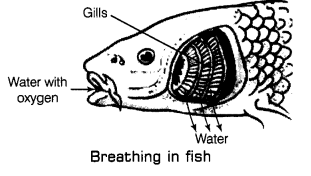 This oxygen is then carried to all the parts of fishes for respiration. The carbon dioxide produced during respiration is brought back by the blood into the gills and expelled into the surrounding water.
This oxygen is then carried to all the parts of fishes for respiration. The carbon dioxide produced during respiration is brought back by the blood into the gills and expelled into the surrounding water.
Q9. Observe the given figures carefully.and answer the following questions.
(a) The amount of CO2 be the highest in which jar. Why?
(b) The amount of CO2 be the lowest in which one and why?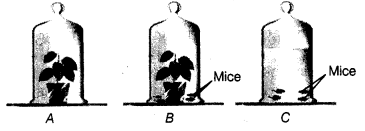 Ans:
Ans:
(a) The amount of CO2 will be the highest in jar C. It is because the mice kept under the jar will breathe out CO2 continuously increasing its amount in the jar.
(b) The amount of CO2 will be the lowest in jar A. It is because in jar A, CO2 released during respiration is used by the plants, i.e. during the process of photosynthesis.
Q10. Whales and dolphins are seen many times releasing a fountain of water sometimes at the surface of water. Why do they do so?
Ans: Sea animals like dolphins and whales live in water but unlike fishes, they do not possess gills for respiration. These possess nostrils which are called blow holes. There blow holes are located on the upper parts of their heads. These animals breathe in through their nostrils and lungs. Dolphins and whales comes to the surface of sea-water from time to time to breathe in air, sometimes whales release a function of water that moves upwards like a spray. This is because when a whale breathes air out of its blow hole it appears as a spray or misp, also called as spont. It can be seen from many miles away. Blow holes are surrounded by muscles that keep the holes closed when the whales or dolphins are under water and opens it when the animal is at the surface and needs to breathe.
Human cannot survive under water because they do not possess any gills to make use of oxygen dissolved in water for breathing. When we go under water we have to take oxygen gas cylinders for breathing.
Q11. A food stall owner was preparing dough for making bhaturas. He added a pinch of yeast and sugar to the dough and left it in a warm place. After few hours, the dough had risen. There was a sour smell too.
(a) Why did the dough rise?
(b) Why did the dough smell sour?
(c) Why was sugar added to the dough?
(d) What would have happened if the dough was kept in the refrigerator, soon after it was prepared?
Ans:
(a) The dough rises due to the release of carbon dioxide during anaerobic respiration by yeast cell.
(b) Yeast, during anaerobic respiration also produces alcohol which results in the sour smell of dough.
(c) Sugar is added into the dough, because it acts as a food for yeast. Yeast upon incomplete breakdown of sugar or food produces CO2, alcohol and energy (in less amount).
(d) If the dough is kept in the refrigerators after it was prepared, then dough will neither raise nor become sour. Yeast requires high temperature to grow, multiply and to respire. At low temperature, the yeast will not respire to produce the byproducts of anaerobic respiration.
Q12. It is not wise to sleep under a tree during night. Why?
Ans: During day, plants photosynthesise in the presence of sunlight and uses CO2 produced during respiration. During this process O2 is released as a byproduct and a balance between O2 and CO2 is maintained in the atmosphere.
But in the night, plants do not photosynthesise. Plants are unable to use CO2 during night and produces CO2 and takes O2 during respiration.
This leads to the increase in the proportion of CO2 in the air.
So, if one sleeps under a tree at night, he will have problems in breathing as the amount of CO2 in the air around will certainly be more than oxygen. Therefore, it is not advisable to sleep under trees during night because the person will suffer from suffocation and feel excess weight on chest.
Q13. (a) Plants lack a specialised respiratory system. How do they carry out respiratory process? Explain.
(b) The plant roots being underground respire by using which mechanism?
Ans:
(a) The plants do not possess any respiratory system still plants respire. The various parts of the plants like leaves, roots, etc., carry out respiration independently.
These parts take in oxygen from air in different manner and utilise it to obtain energy and give out CO2. The leaves of plants possess tiny pores on their surface which is called as stomata. The gaseous exchange during respiration takes place through their stomata.
(b) Roots of the plants respire under the ground. Root cells get oxygen from the air present in the space between the soil particles.
There are several root hairs present on the roots of a plant.
The oxygen from the air (between soil particle) diffuses into root hair and reaches to the cells of the roots. This oxygen is utilised for respiration.
Q14. (a) Respiratory process occurs in two phases, what are those two major steps of respiration? Describe each one.
(b) Define the term breathing rate.
Ans: (a) Respiration is the process of breakdown of food to produce energy for performing various functions. It involves two major steps:
- Inhalation is the process of taking in of air which is rich in oxygen, inside our body.
- Exhalation is the process of giving out of air which is rich in carbon dioxide from our body to the external environment.
(b) The number of times a person breathes, in a minute is called as breathing rate.
An adult human being can inhale or exhale 15-18 times in a minute. It is the average breathing rate of an adult human being. Breathing rate is not constant always.
Q15. Explain the respiratory system in cockroaches.
Ans: A cockroach has small openings on the sides of its body, called spiracles. It also has a network of air tubes called tracheae for gas exchange. Oxygen rich air rushes through spiracles into the tracheal tubes, diffuses into the body tissue and reaches every cell of the body. Similarly, carbon dioxide from the cells goes into the tracheal tubes and moves out through spiracles.
Q16. What are the differences between cellular respiration and breathing.
Ans: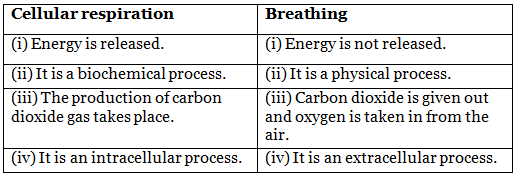
Q17. Differentiate between photosynthesis and respiration.
Ans:
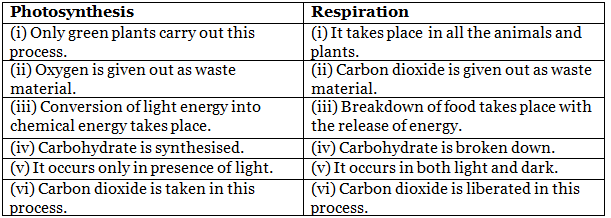
Q18. Describe the process of breathing in human beings.
Ans: When we breathe in, air enters through nasal cavity. The hair and mucus present in the nasal cavity traps dust and other particles present in air. Air from nasal cavity then reaches the pharynx in the neck region and the larynx. Below the larynx is the trachea. The trachea divides into two bronchi, right and left, which leads to the lungs.
In the lungs, each bronchus branches into smaller tubes called bronchioles. At the end of the bronchioles, small rounded structures called air sacs or alveoli are present. Each alveolus is made up of a very thin membrane surrounded by blood vessels. Exchange of gases occur in air sacs through the process of diffusion.
In short passage of air from nose can be depicted as:
Nose → Nasal cavity → Pharynx → Larynx → Trachea → Bronchi → Bronchioles → Alveoli (air sac)
|
112 videos|286 docs|28 tests
|
















